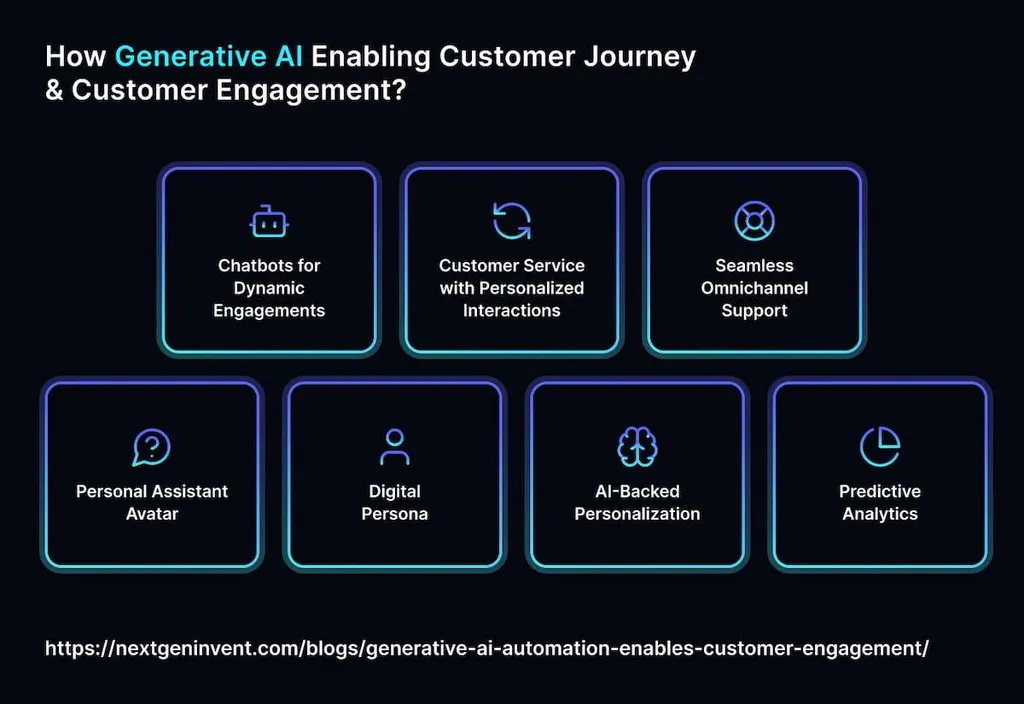The emergence of artificial intelligence (AI) technologies caused a massive shift in how businesses handle client queries. Discovering how to utilize digital virtual assistants to provide personalized, human-like responses 24/7 to queries is paramount for improving the efficiency of customer support teams. This article will delve into the intricacies of generative AI chatbot customer service solutions and provide easy-to-follow guidelines for their implementation.
Due to the rapid development of conversation engines, it might be challenging for firms to integrate AI chatbots and fine-tune their responses without any assistance. Read on to discover how to overcome possible difficulties and process large volumes of client queries without effort.
What is a Generative AI Enterprise Chatbot?
AI-driven chatbots are digital tools programmed to converse with clients utilizing AI and natural language processing (NLP) technologies. They act as digital assistants who help customers with solving tasks of all complexities. Such services provide comprehensive information about products, orders, and shipment issues. Designed to support human-sounding conversations, they can be used across multiple communication channels.
AI chatbots streamline interactions due to their ability to perform the following tasks:
- Recognize text and speech;
- Analyze the customer needs;
- Provide relevant responses to queries.
The rapid adoption of enterprise chatbots stems from the fact that companies can train them to utilize the information collected during interactions.

Their ability to learn and personalize responses makes them invaluable when a firm needs to predict requests and come up with recommendations. There are multiple undisputable upsides to using such tools:
- Accessibility: Programmed virtual helpers provide replies 24/7, enabling entities to minimize response times both outside and during business hours.
- Multitasking: When a firm scales up, AI chatbots can keep several conversations going at the same time.
- Resource optimization: Spending less money on processing customer queries means that companies can invest these funds into development.
Built to enhance customer experience (CX), the most advanced AI tools answer common and more specific queries without any delays. Gradually, they gain the ability to process advanced tasks with high accuracy and delegate solving the most challenging tickets to real agents.
How to Integrate Generative AI Chatbot in Customer Service Systems?
Utilizing AI in business gives early adopters a cutting edge, helping them streamline client journeys and save money. However, when implementing such advanced solutions, firms face multiple barriers. We created easy-to-follow guidelines for those who leverage generative AI chatbot customer service systems. Follow these steps to streamline the process:
- Consider your strategic goals: Formulating a sustainable strategy facilitates the implementation and subsequent usage of AI solutions. Consider the main metrics you need to improve, be it the average response time or client satisfaction rate, and build a roadmap to track your progress toward the set goals.
- Collect data on customers’ favorite communication channels and frequent questions: Analyzing the interactions of your CS agents with clients will give you useful insights on how to improve the quality of your service. Gathering data about frequent issues and pain points enables firms to identify areas for improvement.
- Select the most suitable AI chatbot to cover your needs: The importance of generative AI for enterprises is hard to underestimate, especially if a company finds the right tool to match its needs. Opting for customizable solutions allows firms to build future-proof CS systems that integrate with SaaS solutions and CS software. The best services enable companies to scale their operations and handle complex queries.
- Train your AI tool using datasets based on interactions: Create datasets using the data you collected when analyzing chat logs, emails, and calls. Remove any information that may compromise the privacy of your customers to maintain regulatory compliance. Utilize these datasets to train your AI model and ensure that your chatbot can converse on topics of different complexity and provide responses of high accuracy.
- Perform testing: Analyze your AI chatbot in a controlled environment to fix any issues that may arise. Consider the metrics you aim to improve to achieve the set goals.
- Deploy your generative chatbot: After launching a virtual assistant, analyze feedback to improve your tool.
Following these steps allows firms to improve a chatbot customer engagement rate and get an invaluable tool for solving queries with maximum efficiency.
Tips for Integrating Enterprise-Level AI Chatbots in Client Support
Even though it might be overwhelming to integrate AI chatbots into a CS workflow and ensure their effective functioning, companies should learn how to make the most out of these solutions. Follow these tips to explore their functionality to the fullest:
- Improve response times to boost conversion rates: As 75% of clients expect to get a detailed response within 5 minutes after submitting their queries, use virtual assistants to engage the site visitors. It will help you minimize lead loss and boost your sales.
- Enhance the quality of your services: Using multiple datasets, train your chatbots to offer top-notch assistance and send mistake-free pre-programmed replies to queries.
- Manage high volumes of queries: Ensure that your AI chatbots can process a lot of tickets during peak times.
- Develop clear guidelines to escalate issues to experienced agents: Train your virtual assistants so that they know when a task is too complex for them to solve.
In addition, firms must explore the whole range of opportunities offered by chatbots. Below, we have rounded up some of the most important use cases businesses should consider:
- Customer feedback analysis: Leverage generative AI to detect changes in sentiment and eliminate factors diminishing customer satisfaction. Digital assistants can detect subtle cues and adjust their responses to ensure that their tone of voice suits a client.
- Solve complex issues: AI chatbots learn by responding to queries, so they should be trained to communicate at an advanced level about convoluted problems.
- Improve productivity: Using AI chatbots in a co-piloting mode, human agents can improve their resolution rates and response times.
Besides, you must train your human employees to help them use the power of AI to solve their tasks in no time and establish stronger relationships with customers.
Final Words
Integrating generative AI chatbots in CS systems may be challenging without prior experience. At MetaDialog, we strive to boost customer satisfaction by offering tailored solutions for enterprises that want to process all kinds of queries more quickly. Leveraging new technologies, we developed a cost-effective AI-driven chatbot compatible with SaaS solutions, messengers, and CS platforms.
Seeking to make interactions with clients more engaging, we employ cutting-edge technological solutions to transform customer journeys, boost sales, and perform process optimization. Utilize our generative AI chatbot customer service solutions to speed up your workflow, automate tasks, and handle queries more effectively. MetaDialog’s chatbots seamlessly integrate with web-based platforms, databases, and APIs. Book our demo today and optimize your processes using our fully compliant Generative AI solution with robust security measures and multi-language support.
